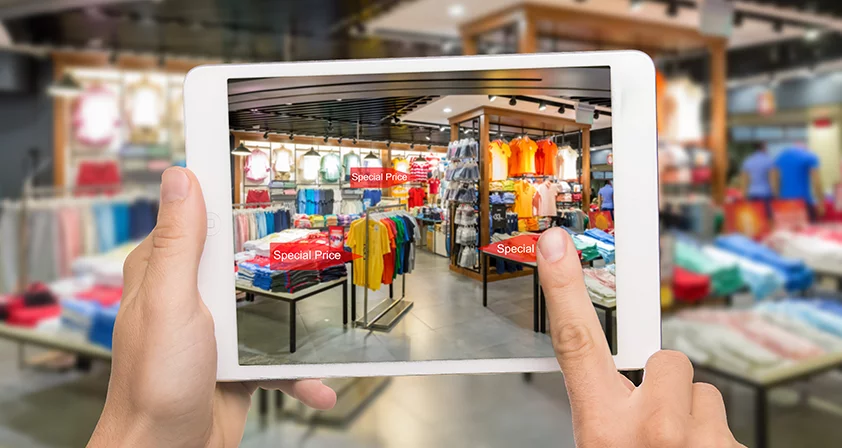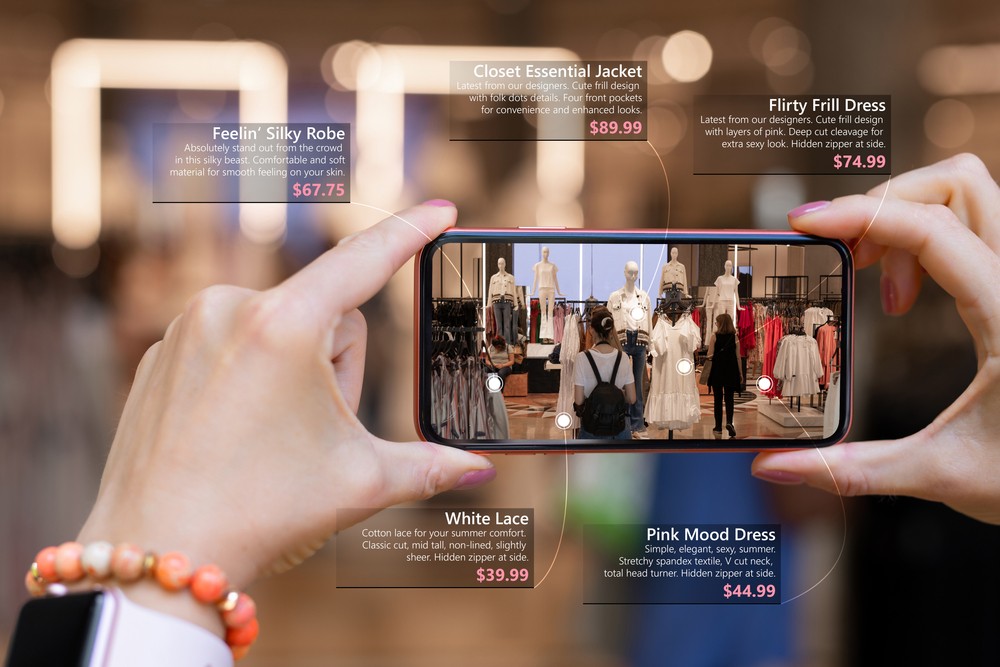Technology
Augmented Reality in Retail: Enhancing the Customer Experience

The retail landscape is undergoing a dramatic transformation. Consumers today expect more than just a physical store or an online shopping cart. They crave engaging experiences that bridge the gap between the digital and physical worlds. This is where Augmented Reality (AR) emerges as a game-changer, revolutionizing the way customers interact with products and brands. This comprehensive exploration delves into AR in retail, examining its core concepts, the diverse applications it offers, and the transformative impact it has on the customer experience.
1. Demystifying AR: Beyond the Hype
AR is not to be confused with Virtual Reality (VR). Here’s a breakdown of the key differences:
- Augmented Reality: AR superimposes computer-generated content onto the real world, viewed through a smartphone or tablet camera. It enhances the user’s perception of the physical environment with additional digital information or interactive elements.
- Virtual Reality: VR creates a completely immersive and simulated environment, experienced through a VR headset that blocks out the real world. Users feel entirely transported to a virtual space.
Real-Life Example: Imagine trying on a pair of sunglasses virtually through your phone’s camera, seeing how they look on your face before purchasing them online. This is AR in action.
2. Unveiling the Toolbox: Essential AR Technologies
AR experiences rely on a combination of technologies:
- Computer Vision: Software algorithms analyze the user’s camera feed to identify real-world objects and surfaces where AR elements will be overlaid.
- 3D Modeling: Products or other digital elements are created as 3D models for realistic and accurate interaction within the AR experience.
- Motion Tracking: The AR software tracks the user’s movements and device orientation, ensuring the virtual elements are positioned and scaled correctly within the real-world environment.
- Real-Life Example: A furniture store’s AR app might use computer vision to recognize your living room floor and then allow you to virtually place a 3D model of a sofa in that space, adjusting its position and orientation based on your movements.
3. A Spectrum of Applications: How AR is Transforming Retail
AR offers a variety of applications that enhance the customer experience across different retail segments:
- Virtual Try-On: Imagine trying on clothes, makeup, or even glasses virtually before purchasing them. AR apps allow users to see how products would look on them, reducing returns and improving customer satisfaction.
- Real-Life Example: Sephora’s Virtual Artist app allows customers to virtually try on different makeup shades and styles, providing a more personalized and engaging beauty experience.
- Product Visualization in Context: AR can help customers visualize how furniture, appliances, or other home decor items would look in their own spaces, considering size, scale, and color variations.
- Real-Life Example: IKEA Place allows customers to virtually place furniture models within their homes using their smartphones, ensuring a perfect fit before purchase.
- Interactive Product Information: AR can overlay product information, specifications, and even customer reviews directly onto physical products, providing a richer and more interactive shopping experience.
- Real-Life Example: The Lowe’s AR app allows customers to scan product barcodes and view detailed information, assembly instructions, and even 3D animations demonstrating product functionality.
- Gamified Shopping Experiences: AR can integrate gamification elements like treasure hunts or product scavenger hunts within stores, making shopping more interactive and engaging, especially for younger demographics.
- Real-Life Example: Macy’s partnered with Pokemon Go to create an AR scavenger hunt within its stores, driving store traffic and customer engagement.
4. Beyond the Showroom: AR for Enhanced Customer Engagement
AR applications extend beyond the physical shopping experience:
- Interactive In-Store Displays: AR can transform static displays into interactive experiences, providing product information, showcasing product variations, and offering customers a more engaging way to learn about products.
- Real-Life Example: Adidas uses AR displays in stores that allow customers to view product details, customization options, and even watch interactive videos about the product’s history or manufacturing process.
- Personalized Marketing and Promotions: AR can be used to deliver targeted marketing messages and promotions based on a customer’s location, browsing history, or previous purchases.
- Real-Life Example: Retailers can leverage AR apps to send location-based notifications to customers as they enter a store, highlighting special offers or showcasing products relevant to their interests.
- Improved Customer Service: AR can empower store associates with real-time product information and inventory data, allowing them to provide more personalized and efficient customer service.
- Real-Life Example: AR apps can guide store associates to the location of requested items within the store and provide them with additional product information and customer reviews to enhance their service interactions.
5. Building the AR Experience: Considerations and Challenges
While AR in retail holds immense potential, there are considerations and challenges to navigate:
- Technical Requirements: Developing and maintaining AR experiences requires specialized skills and resources. Retailers need to invest in AR development or partner with AR technology providers.
- Device Compatibility: AR experiences need to be compatible with a wide range of smartphones and tablets to ensure accessibility for a broad customer base.
- Data Security and Privacy: Collecting and utilizing customer data for AR experiences requires robust data security measures and clear privacy policies to build trust with customers.
- User Experience (UX) Design: Creating intuitive and user-friendly AR interfaces is crucial for customer adoption. Complex or poorly designed AR experiences can deter users and frustrate their shopping journey.
- Integration with Existing Systems: AR experiences need to integrate seamlessly with existing retail infrastructure, including inventory management systems and customer relationship management (CRM) platforms.
Real-Life Example: Retailers might struggle to ensure their AR apps function smoothly on all devices or integrate seamlessly with their legacy point-of-sale systems, creating challenges for both customers and store associates.
6. A Glimpse into the Future: Emerging Trends in AR Retail
The future of AR in retail is brimming with exciting possibilities:
- The Rise of AR Cloud: Cloud-based AR platforms will enable retailers to develop and deploy AR experiences without requiring extensive technical expertise or infrastructure investment.
- AR Shopping in the Metaverse: As the metaverse evolves, expect AR experiences to play a significant role in virtual shopping environments, allowing customers to interact with products and brands in immersive digital spaces.
- Hyper-Personalization with AI: Integration of Artificial Intelligence (AI) with AR will enable personalized product recommendations, targeted promotions, and even customized AR experiences tailored to individual customer preferences.
- The AR Shopping Assistant: Imagine a future where AR glasses or smart wearables act as your personal shopping assistant, providing product information, price comparisons, and even offering styling suggestions in real-time as you browse physical stores.
- Sustainability and Responsible Sourcing: AR can be leveraged to educate customers about the origin and sustainability practices behind products, promoting informed purchasing decisions.
Real-Life Example: Early adopters like Rebecca Minkoff are experimenting with AR shopping experiences in the metaverse, allowing customers to virtually explore their collections and interact with products in a digital environment.

7. Conclusion: The AR Revolution in Retail – A Bridge Between Physical and Digital
AR is revolutionizing the retail landscape, blurring the lines between the physical and digital worlds. By embracing AR, retailers can create more engaging and interactive shopping experiences, leading to increased customer satisfaction, improved brand loyalty, and ultimately, greater sales success. Here are some key takeaways:
- Enhanced Customer Experience: AR empowers customers to interact with products in new and innovative ways, fostering a more enjoyable and informative shopping journey.
- Data-Driven Personalization: AR allows retailers to leverage customer data to personalize product recommendations, promotions, and AR experiences, catering to individual needs and preferences.
- Improved Operational Efficiency: AR can streamline tasks for store associates, optimize inventory management, and provide real-time product information for improved customer service.
- Data Security and Privacy: Building trust with customers requires robust data security measures and transparent privacy practices when utilizing AR technology.
- The Future is Immersive: As AR technology matures and integrates with the metaverse, expect even more immersive and interactive shopping experiences to emerge.
8. Call to Action: Embracing the AR Opportunity
Whether you’re a large retail chain or a small business owner, the potential of AR is within reach. Here are some steps to get started:
- Identify Your Goals: Define what you want to achieve with AR technology. Do you want to improve product visualization, personalize marketing campaigns, or enhance in-store customer service?
- Evaluate Your Resources: Assess your technical expertise and budget to determine if in-house AR development is feasible or if partnering with an AR technology provider is a better option.
- Start Small and Scale Up: Begin with a pilot project focused on a specific area of your retail operations. As you gain experience and demonstrate success, you can scale up your AR initiatives.
- Prioritize User Experience: Focus on creating intuitive and user-friendly AR experiences that seamlessly integrate into your existing customer journey.
- Measure and Analyze Results: Track the impact of your AR initiatives on key metrics such as customer engagement, conversion rates, and brand awareness.
By embracing AR strategically, retailers can create a competitive edge, cater to the evolving needs of customers, and navigate the ever-changing retail landscape. Here are some additional considerations:
- Stay Informed: Keep up-to-date with the latest advancements in AR technology and how other retailers are utilizing AR to gain inspiration and identify potential applications for your own business.
- Collaborate with Technology Partners: Partnering with AR technology providers can give you access to expertise, resources, and development tools to create high-quality AR experiences for your customers.
- Focus on Accessibility: Ensure your AR experiences are accessible to a broad customer base by considering device compatibility and offering alternative options for customers who might not have access to AR-enabled devices.
- Ethical Considerations: Be mindful of the potential ethical implications of AR in retail, such as data privacy concerns or the over-commercialization of physical spaces.
Real-Life Example: Retailers can partner with companies like Google or Apple who are actively developing AR technology and toolkits for businesses. This collaboration can provide retailers with the support and resources needed to implement AR solutions effectively.
9. A Look Ahead: The Future of Customer-Centric Retail
The future of retail is customer-centric, with AR playing a pivotal role in shaping a more personalized, engaging, and ultimately, satisfying shopping experience. Here’s what we can expect:
- The Rise of Experiential Retail: Physical stores will evolve into experiential hubs, utilizing AR to create interactive environments and product demonstrations that go beyond traditional shopping.
- AR-Powered Training and Support: AR can be leveraged to train store associates on product knowledge and provide remote customer support through visual aids and real-time product demonstrations.
- Social Shopping and Community Building: AR can foster social shopping experiences by allowing customers to share AR product experiences with friends and family, driving social media engagement and brand advocacy.
- Sustainability and Transparency: AR can be used to educate customers about the environmental and ethical impact of products, empowering them to make informed purchasing decisions.
Real-Life Example: Imagine a future where a furniture store allows customers to virtually place a 3D model of a sofa in their living room, complete with an AR overlay that showcases the sofa’s sustainable materials and eco-friendly manufacturing process.
10. Conclusion: The AR Revolution has Begun
AR is not just a futuristic concept; it’s a transformative technology shaping the retail landscape today. By embracing AR with a clear vision and a customer-centric approach, retailers can create a competitive edge, build brand loyalty, and ultimately drive long-term success. The future of retail is immersive, interactive, and informed by AR technology. Are you ready to join the revolution?
